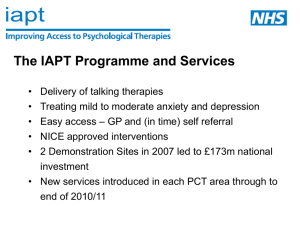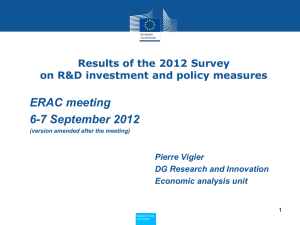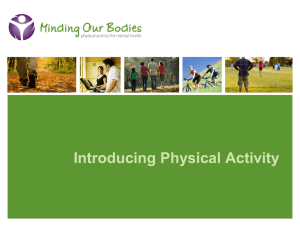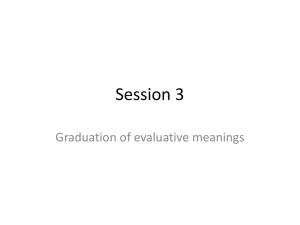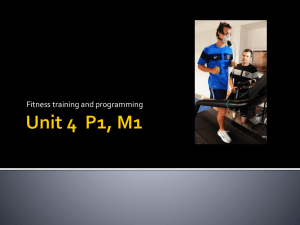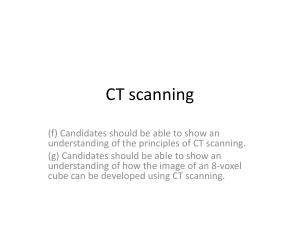McLennan, Noble, Roberts social exposure to inequality. Results
advertisement
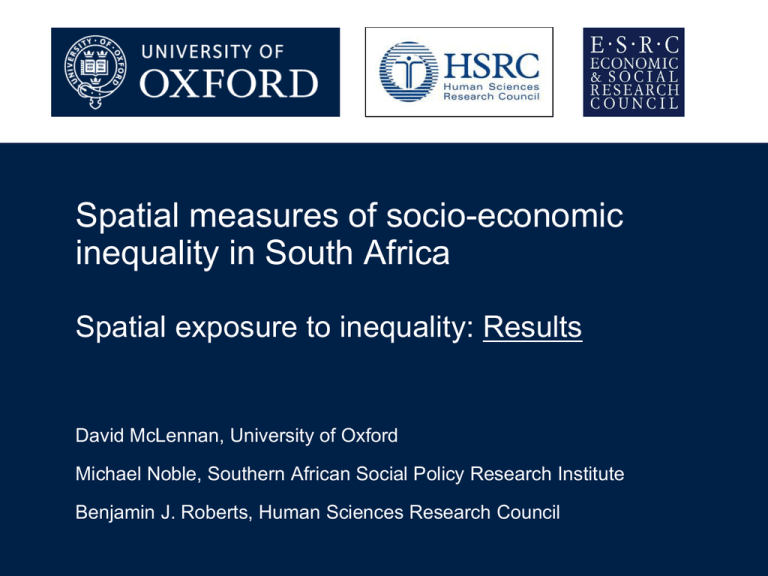
Spatial measures of socio-economic inequality in South Africa Spatial exposure to inequality: Results David McLennan, University of Oxford Michael Noble, Southern African Social Policy Research Institute Benjamin J. Roberts, Human Sciences Research Council Exposure of ‘poor’ to ‘non-poor’ Exposure of poor to non-poor national datazone deciles ExposIncxy 1500 1000 0 500 Frequency 2000 2500 Chart 23: National distribution of datazone Exposure scores - Income - 0 .2 .4 Exposure score .6 .8 Chart 24: National distribution of datazone Exposure scores - Income By metro/non-metro status Non-Metro 0 1000 Frequency 2000 3000 Metro 0 .2 .4 .6 .8 0 Exposure score Graphs by metro_status .2 .4 .6 .8 Table 1: Exposure of poor to non-poor: location of datazones in the 10% highest ExposIncxy decile nationally Municipality Number Percentage City of Cape Town 986 44.5 City of Tshwane Metro 502 22.7 City of Johannesburg Metro 290 13.1 Ekurhuleni Metro 206 9.3 Others (23 municipalities) 232 10.5 2,216 100.0 Total in the 10% highest exposure decile nationally Table 2: Exposure of poor to non-poor: location of the ten municipalities with the largest proportions of datazones in the highest ExposIncxy decile nationally Municipality Gamagara Stellenbosch City of Cape Town Saldanha Bay City of Tshwane Metro Mossel Bay City of Johannesburg Metro George Ekurhuleni Metro Nokeng tsa Taemane Number of datazones in the municipality 9 60 1388 34 951 37 1599 67 1188 21 Number of datazones in the 10% highest ExposIncxy decile nationally 7 44 986 23 502 10 290 12 206 3 Percentage of municipality datazones in the 10% highest ExposIncxy decile nationally 77.8% 73.3% 71.0% 67.6% 52.8% 27.0% 18.1% 17.9% 17.3% 14.3% Focus on the metropolitan municipalities (Exposure of ‘poor’ to ‘non-poor’) 1 Chart 25: Datazone deprivation rate against exposure score - Income - Cape Town Johannesburg Tshwane .5 Ekurhuleni Buffalo City eThekwini Nelson Mandela 0 Mangaung 0 .5 Income Deprivation score 1 1 Chart 26: Datazone deprivation rate against exposure score - Employment - Cape Town Johannesburg Tshwane .5 Ekurhuleni Buffalo City eThekwini Nelson Mandela 0 Mangaung 0 .5 Employment Deprivation score 1 1 Chart 27: Datazone deprivation rate against exposure score - Education - Cape Town Johannesburg Tshwane .5 Ekurhuleni Buffalo City eThekwini Nelson Mandela 0 Mangaung 0 .5 Education Deprivation score 1 1 Chart 28: Datazone deprivation rate against exposure score - Living Environment - Cape Town Johannesburg Tshwane .5 Ekurhuleni Buffalo City eThekwini Nelson Mandela 0 Mangaung 0 .5 Liv Env Deprivation score 1 ap e ity M in i o C ity an ga un g Bu ffa l M ek w a g an de l eT h on el s ha nn es bu r hu le ni n an e To w hw Ts Ek ur C C in i a an ga un g o ek w an de l Bu ffa l M n hu le ni To w g .4 .5 .6 .8 .7 Exposure .75 .8 .85 Education Jo M eT h on el s ap e Ek ur C ha nn es bu r an e .7 N N ity M o C ity a in i an de l Bu ffa l on ek w an ga un g rh ul en i eT h M Ek u n g To w an e C hw ap e Ts o an ga un g a in i an de l ek w ha nn es bu r C g rh ul en i Bu ffa l M M n an e To w hw eT h Ek u on el s Jo Ts ap e ha nn es bu r el s Jo C .4 .2 .5 .3 .5 .6 Exposure .4 Exposure .7 .6 .8 .7 Income N N Jo hw Ts .65 Exposure Chart 29: Exposure Scores - Metropolitan municipalities Employment Living Environment Tables 3 & 4: Spearman rank correlation coefficients between the four dimension-specific exposure measures Table 3: All metropolitan datazones (n=7,800) Expos_Inc Expos_Inc Expos_Emp Expos_Edu Expos_Liv 1 Expos_Emp 0.9171 1 Expos_Edu 0.8104 0.8281 1 Expos_Liv 0.8947 0.7821 0.7225 1 Table 4: City of Cape Town datazones only (n=1,388) Expos_Inc Expos_Inc Expos_Emp Expos_Edu Expos_Liv 1 Expos_Emp 0.9344 1 Expos_Edu 0.8752 0.8861 1 Expos_Liv 0.9339 0.8592 0.8116 1 Creating ExposFacxy 1. Each of the four separate dimension-specific exposure scores at Datazone level was ranked and transformed to a normal distribution. 2. The four normalised rank variables were entered into a maximum likelihood factor analysis. 3. Weights derived from the factor analysis were used to combine the four normalised rank variables to form a single composite measure at Datazone level: ‘ExposFacxy’. 4. The 7,800 metropolitan Datazones were re-ranked on the ExposFacxy measure. Chart 30: Datazone Exposure Factor Ranks by Municipality falo City Buf Man gau ng and ela Nel son M i kwin eTh e eni Eku rhul Joh ann esb urg Tow n Cap e Tsh wan e 7,800 3,900 1 Interquartile Range ranked WITHIN Metropolitan Municipalities Mel Blou kbo ber ss g Milntrand Dur erto Goobanvilln Bra dwooe cke d B nfell Houellville Fi t Ba Capsh Hoey S im e T k on's own Epp Kuils Town ing InduRiver s Mamtria re A SomMuizetlantis erse nber tW g Gor Parest Gradons Bow ssy ay Pa Kom met rk Cap Peljie e M la e Kra Belhtro aifo ar n Eer Athlotein ste Elsi Rivne B es R ier Mitclue Doivier Imiz hells wns amo Plain City Ye of C ape Str thu T Mat ow and roos n N U f Macontein ass a GugLangar u le N Fistoordhothu ante ek Blac kraa khe l at Delh N Cro yang ft ssro a Philads ip Kha Mfulepi yeli ni Nom tsha zam o 7,800 3,900 1 Chart 31: Datazone Exposure Factor ranks by Cape Town MainPlace Interquartile Range ranked WITHIN Metropolitan Municipalities Tem ban Eku i phu ml e Villa ni ge V 1S outh Man dela Par Villa k ge V 2N orth Villa ge V 1N orth Tre vor V ila kaz Grif i fiths Mxe Kha nge yeli tsha T3Kha V3 yeli tsha T3Har V4 are/ Hol imis Villa a ge V 4N Kha orth yeli tsha T3V5 Tow Villa n3 ge V 3N orth Vict oria Mer ge Ikw ezi Par Kha k yeli tsha SP Mon wab is i Silv e Kha r To yeli wn tsha T2Solo V2b mon M ahla Bon ngu gan i TR Sec tion RR Sec tion 3,500 3,000 2,500 2,000 1,500 Chart 32: Datazone Exposure Factor ranks by Khayelitsha SubPlace Interquartile Range ranked WITHIN Metropolitan Municipalities Summary of Exposure results Exposure to socio-economic inequality is typically highest in the urban areas, particularly the metropolitan municipalities. There are strong correlations at datazone level between the four separate dimension-specific measures of exposure (income, employment, education, living environment) The composite ExposFacxy measure constructed across the 7,800 metropolitan datazones shows that exposure is typically highest in Tshwane and Cape Town, but that there is far more variation within Tshwane than within Cape Town. The exposure results can be analysed at a detailed geographical level to explore variations within municipalities. Community ‘Intensity’ of exposure (‘poor’ to ‘non-poor’): National analyses Neighbourhood ‘Intensity’ of exposure to socio-economic inequality The exposure measures represent the likelihood of a given individual living in a given neighbourhood of being exposed to socio-economic inequality. Typically, a geographical area with low poverty rates (e.g. Sandton) will be characterised by relatively high levels of exposure amongst the poor population. But some neighbourhoods (e.g. Alexandra) have high poverty and high exposure to inequality. In these areas, it may be argued there is a high community-level ‘intensity’ of exposure to inequality. .8 .6 .4 0 aLDPxyi* ExposIncxy score .2 0 .2 .4 .6 dz_rate_inc Proportion of population income deprived lowest_percentile_intensity .8 highest_percentile_intensity 1 Chart 33: National distribution of datazone Intensity scores - Income By metro/non-metro status Non-Metro 1000 0 500 Frequency 1500 2000 Metro 0 .2 .4 .6 0 Intensity score Graphs by metro_status .2 .4 .6 Intensity of exposure (‘poor’ to ‘non-poor’): Focus on the metropolitan municipalities Tables 5 & 6: Spearman rank correlation coefficients between the four dimension-specific ‘intensity’ measures Table 5: All metropolitan datazones All Metros intensity_inc intensity_emp intensity_edu intensity_liv 1 intensity_inc intensity_emp 0.8245 1 intensity_edu 0.7960 0.7068 1 intensity_liv 0.8810 0.7529 0.8399 1 Table 6: City of Cape Town datazones only Just Cape Town intensity_inc intensity_inc intensity_emp intensity_edu intensity_liv 1 intensity_emp 0.9329 1 intensity_edu 0.8666 0.8122 1 intensity_liv 0.9320 0.8780 0.8402 1 Chart 34: Datazone Intensity Factor Ranks by Municipality Tow n Cap e wan e Tsh falo City Buf Joh ann esb urg and ela Nel son M Man gau ng i kwin eTh e Eku rhul eni 7,800 3,900 1 Interquartile Range ranked WITHIN Metropolitan Municipalities Summary of ‘Intensity’ results ‘Intensity’ can be regarded as a measure of the degree to which neighbourhoods are characterised by the twin stressors of high poverty and high exposure to socioeconomic inequality. High correlations exist between the four dimensionspecific intensity measure, justifying the construction of an ‘IntensityFacxy’ composite measure. Datazone neighbourhoods with very high levels of ‘intensity’ are found in all metropolitan municipalities. All eight metro municipalities exhibit a wide range of datazone level intensity scores, i.e. heterogeneity. Conclusions Spatial inequality measures – particularly the P* Exposure indices – offer a valuable contribution to the evidence base concerning inequality in South Africa. They provide a means to examine geographical patterns in people’s lived experience of inequality. They can be used as explanatory factors when analysing attitudinal data (as is the focus of the ESRC/NRF-funded project). They can also be used to identify geographical areas characterised by both high levels of poverty and high levels of exposure to inequality, which may be most at risk of social unrest or high levels of crime (our ‘Safe and Inclusive Cities’ project). David McLennan david.mclennan@spi.ox.ac.uk


